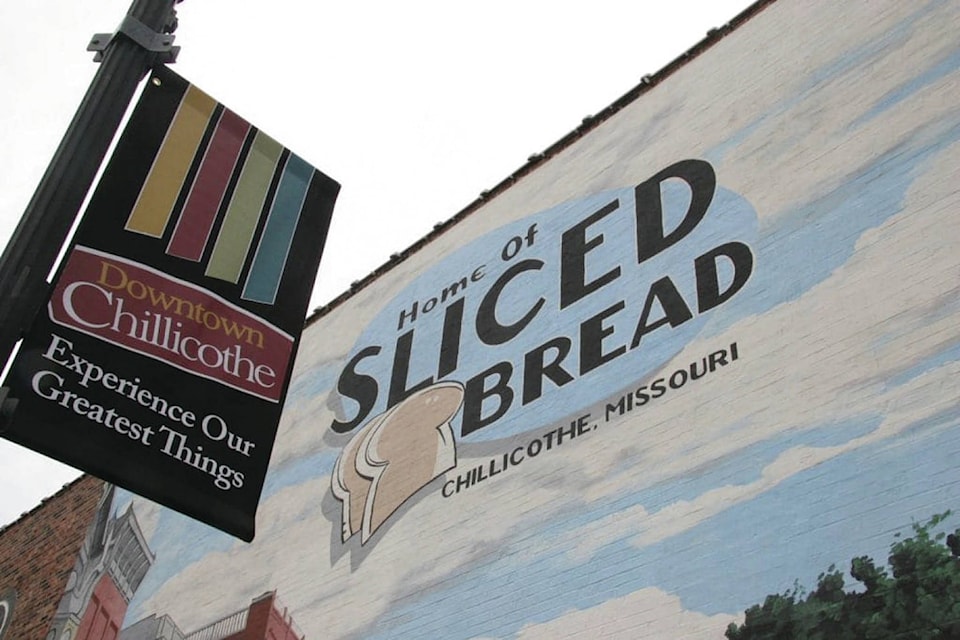U.S. Route 36 stretches for 200 miles across the flat farmland of northern Missouri, connecting Kansas to Illinois. At one end is the Pony Express Bridge in St. Joseph and at the other is the Mark Twain Memorial Bridge in Hannibal.
The route is called “The Way of American Genius” because some of the nation’s best-known innovators, creative minds and a military hero spent parts of their childhood near towns along the route, including Samuel Clemens, a.k.a Mark Twain (Hannibal), Walt Disney (Marceline), Gen. John J. Pershing (Laclede) and James Cash “J. C.” Penney (Hamilton).
For ages, Chillicothe, a town of 9, 500 along the route, felt left out. As far as anyone knew, nothing had been invented there of equal stature.
Then, in 2001, a local journalist, combing through microfilm of old newspapers, stumbled upon a slice of American innovation long overlooked by local residents and state historians. The headline on an old news clipping said: “SLICED BREAD IS MADE HERE.”
It appeared on the front page of the Chillicothe Constitution-Tribune on July 6, 1928, the day before the first machine-sliced bread would be sold to customers. “The Chillicothe Baking Company,” it said, “has installed a power driven multi-bladed bread slicer which performs a feat which heretofore had been considered by bakers as being impossible — namely, the slicing of loaves.”
That bakery, run by Marion “Frank” Bench, was the first in the nation to sell commercially sliced and wrapped bread. Other bakers said it couldn’t be done without the loaves losing their freshness. The bread was first sold the same year that Disney created Mickey Mouse, just months before the Great Depression.
A Chillicothe newspaper ad promoted the breakthrough as “the greatest forward step in the baking industry since bread was wrapped.” Soon others were using the phrase “the greatest thing since sliced bread” to hype inventions that followed and, for that matter, a lot of other things. President Barack Obama invoked the saying after the Chicago Cubs won the World Series in 2016, their first title in 108 years.
“No one says, ‘It’s the greatest thing since the cellphone,’” said Ed Douglas, president of Chillicothe’s Slice Bread Corp., because the automated bread slicer is “the American innovation by which others are measured.”
Now Chillicothe is hoping for additional recognition. A bill moving through the Missouri House calls for designating July 7 as “Missouri Sliced Bread Day.” If passed, the measure will go to the state Senate for consideration. The St. Louis Post-Dispatch’s editorial board called it the legislature’s “weirdest bill.”
“It’s a wonderful bill. Sliced bread is major deal,” countered a co-sponsor of the bill, Rep. Nate Walker, R, of Kirksville, who last month proposed changing part of a U.S. highway in northeast Missouri to “Bluegrass Queen Rhonda Vincent Highway.”
The bread bill celebrates Chillicothe’s role in food history. But it doesn’t mention that an Iowan, Otto Frederick Rohwedder, created the bread-slicing machine used in Bench’s bakery. Although the invention forever changed the way Americans eat, it did not make Rohwedder famous or wealthy.
Rohwedder didn’t set out to become an inventor. He earned a degree in optics in 1900 from the Northern Illinois College of Ophthalmology and Otology in Chicago. Then he moved to Missouri, where he eventually operated three jewelry stores in St. Joseph, about 70 miles west of Chillicothe.
On the side, he tinkered with a design for a mechanized bread slicer. In 1916, he sold his jewelry business and moved back to his home town of Davenport, Iowa, to focus his energy on the slicer and recuperate from an illness.
Rohwedder wasn’t the first to attempt making an automated bread slicer, according to the Atlantic: “While the earlier bread-cutting devices using parallel blades appear in America in the 1860s, they sat on the shelf for decades, awaiting the introduction of other machines capable of producing loaves of uniform shape, size and consistency.”
In 1917, Rohwedder’s prototype, including the blueprints, were destroyed in a fire at an Illinois factory that he hoped would produce his commercial bread slicers. It would take nearly a decade for him to secure the funds needed to begin manufacturing again.
“It was a real story of determination,” Douglas said.
As he improved his invention, Rohwedder sought feedback from homemakers to determine how thick to cut the slices (half an inch). He also had to find a way to ensure the bread would stay fresh once it was sliced. First, he inserted large U-shaped pins at both ends of the bread to keep the pieces from separating. Then he created a process so that the bread was quickly sealed in a bag after being sliced.
Many bakers initially opposed factory-sliced bread. But Rohwedder’s baker friend in Chillicothe signed on. After a few years in business, Frank Bench had fallen on hard times and seemingly had nothing to lose, Douglas said.
The patent for the automated slicer explained how it worked, according to the Smithsonian: “The machine moved the bread into the slicer and then a series of ‘endless cutting bands’ sliced the loaf before moving it along to where it could easily be packaged by a specially designed bread wrapping machine — another patent of Rohwedder’s.”
